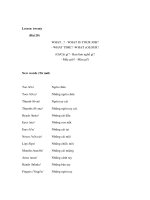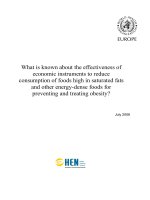Spider silk - what is spider silk
Bạn đang xem bản rút gọn của tài liệu. Xem và tải ngay bản đầy đủ của tài liệu tại đây (2.09 MB, 20 trang )
Spider Silk
Prepared By : Mazadul Hasan sheshir
ID: 2010000400008
13th Batch (session 2009-2013)
Department : Wet Processing Technology
Email:
Blog : www. Textilelab.blogspot.com (visit)
Southeast University
Department Of Textile Engineering
I/A 251,252 Tejgaon Dhaka Bangladesh
Prepared By :
©right
Spider silkaby. Spider Silk is a natural fiber secreted by spiders for the
production of webs and egg sacs as well as transportation. Spiders use
theirmakeother structures, which function as nets to catch other animals, or as
nests or cocoons for protection for their offspring. They can also suspend
themselves using their silk. The silk is secreted from glands inside the spiders
spinnerets, located on the back of a spiders abdomen. Spider silk is renounced
for being stronger than steal by mass and is surprisingly elastic and has
generated interest for an array of applications. Allegedly, these properties are a
result of both its structure and chemical make up.
What is Spider Silk?
Spider Silk?
Extraction and weaving of Spider Silk
1. Silks have a hierarchical structure (e.g., cellulose, hair).
2. The primary structure is its amino acid sequence, mainly consisting of highly
repetitive glycine and alanine blocks.
3. On a secondary structure level, the short side chained alanine is mainly found in the
crystalline domains of the nanofibril, glycine is mostly found in the so-called
amorphous matrix consisting of helical and beta turn structures. It is the interplay
between the hard crystalline segments, and the strained elastic semi-amorphous
regions, that gives spider silk its extraordinary properties .
Structure
Cross section of spider silk showing
Cluster of round spots of varying size and
fibers are extremely circular Cluster of
round spots of varying size and fibers are
extremely circular
Cross section of silk worm fiber showing
Triangular shape and fibers are held by
mercerized cotton to help support the
fiber when they are cut
Figure: Under microscope with partially cross polarized light to help enhance their structure
Comparison of golden orb spider silk with cultivated silk worm moth bombyx mori
Longitudinal view of spider silk fiber
showing TWO distinct fiber types. Thicker
more homogeneously yellow fiber are the
fibers with all the incredible physical
properties
Longitudinal view of silk worm fiber
showing thinner white or colorless
fiber
Figure: Under microscope with partially cross polarized light to help enhance their structure
Spider Silk Vs Cultivated Silk
1. In 2000, Canadian biotechnology company Nexia successfully produced spider
silk protein in transgenic goats that carried the gene for it; the milk produced
by the goats contained significant quantities of the protein, 1–2 grams of silk
proteins per liter of milk. Attempts to spin the protein into a fiber similar to
natural spider silk resulted in fibers with tenacities of 2–3 grams per denier
2. In March 2010, researchers from the Korea Advanced Institute of Science &
Technology (KAIST) have succeeded in making spider silk directly with the
bacteria E.coli, modified with certain genes of the spider Nephila clavipes.
Thus, this eliminates dependency on the spider for milking and allows to
manufacture the spider silk at a more cost-effective manner.
Recent attempts to develop materials with comparable properties to
Spider Silk
Spider silk has amazing physical properties. They are
1. Extremely elastic
2. Extremely strong
3. Stronger than Kevlar
Amazing Properties Of Spider Silk
Spider silk provides the best balance of strength and toughness as shown in the
stress-strain curve
· The stress-strain curve of the spider silk assumes a sigmoidal shape similar
to that of an elastomer, demonstrating a well balance of strength and
elongation at 1.75 GPa (15.8 g/den) and 36%, respectively.
· This "rubber-like" stress-strain curve is characterized by three distinct
regions:
Region I (0-5%) is characterized by a high initial modulus of 34 GPa;
Region II (5-21%) shows a pseudo yield point at 5 % before strain
hardening to a maximum modulus of 22GPa at 22% elongation and
Region III (21-36%) exhibits a gradual reduction of modulus until reaching
failure strength of 1.75 GPa. at 36% elongation.
· An examination of the area under the stress-strain curves shows a toughness
level of 2.8 g/denier. This is much higher than the toughness of the aramid
fiber (0.26 g/denier) and nylon 6 fiber (0.9 g/denier)
Amazing Properties Of Spider Silk
Mechanical properties of Spider Silk
Mechanical properties
Most spider silk have exceptional mechanical properties. They exhibit a unique
combination of high tensile strength and extensibility (ductility). This enables a
silk fiber to absorb a lot of energy before breaking (toughness, the area under a
stress-strain curve).
Strength
In detail a spider silk’s tensile strength is comparable to that of high-grade
alloy steel (450 - 1970 MPa),and about half as strong as aramid filaments, such
Kevlar (3000 MPa).
Extensibility
Silks are also especially ductile, with some able to stretch up to four times their
relaxed length without breaking.
Toughness
The combination of strength and ductility gives dragline silks a very high
toughness (or work to fracture), which "equals that of commercial
polyaramid (aromatic nylon) filaments, which themselves are benchmarks of
modern polymer fiber technology".
Figure: Tensile Stress-Strain Curves of Spider Silk and other
Polyamide Fibers
Mechanical properties of Spider Silk
Potential of spider silk:
1. Military and medical arenas.
2. Experiments with producing synthetic fibers.
3. Use of spider silk in bio medical application.
4. Component of artificial tendons and ligaments.
5. Guides for re growing nerves.
6. Scaffold for tissue growth
Application of spider silk
Figure: Bio-artist Jalila Essaidi, used spider-goat silk to create "bulletproof skin",
and a .22 caliber bullet, fired at a reduced speed, hitting but not breaking the
skin.
Application of spider silk
Scientists mix in metal to make super-strength spider silk
Scientists have now found that they can make spider silk even tougher by
infiltrating some metal atoms into the spider's handiwork. To get the metal into
preexisting dragline silk, the authors used an atomic layer deposition technique,
which uses repeated pulses of vaporized material that contains metals. In this
case, they tried several metal compounds, including diethyl zinc, trimethly
aluminum, and a titanium compound, all vaporized in the presence of water.
Water alone was used as a control. All of the compounds dramatically increased
both the tensile strength of the silk, as well as its extensibility. In short, the
researchers had taken an unusually tough material and made it even tougher,
with the best results produced by the aluminum and titanium treatments.
Application of spider silk
Scientist Uses Spider Silk for Violin Strings
Spider silk is turning out to be a remarkably versatile material. Aside from having
a higher heat conductivity than any other organic matter and proteins for inserting
genes into cells, strings from a spider have also been found to have a very high
tensile strength. One researcher in Japan has studied this property of spider silk for
decades, and recently unveiled a new application for it by weaving together
thousands of strands of spider filaments and using them as violin strings.
Application of spider silk
Spider Silk as Artificial Muscle
Scientists at the University of Akron have developed two new ways to apply spider
silk, and normal silk from silkworms, to artificial muscles. If refined and
commercialized, scientists say the silk could be used in everything from robotics to
microchip systems.
Like human muscle, spider silk muscles would have degrees of movement,
depending on the amount of water in the air around the muscle. High humidity
would mean maximum contraction, low humidity would loosen the treads. Water
breaks apart the hydrogen bonds inside the thin strands of protein, causing new,
contracting bonds, to form. As the water evaporates the hydrogen bonds reform in
their original positions.
Application of spider silk
INFORMATION & CAUTECY
Md. Salim Azad Didar
I.D: 201000400038
Batch: 13th-1
Department : Wet Processing Technology
Southeast University
Department Of Textile Engineering
1. Zemlin, J. C., A Study of the Mechanical Behavior of Spider Silks, U. S. Army Natick
Report AD 333, 19 .
2. www.wikipedia.com
3. Kaplan, D., Adams, W. W., Famler, B., and Viney, C., editors, Silk Polymers: Materials
Science and Biotechnology, .ACS Symposium Series 544, American Chemical Society,
DC
4. Marples, B. J., "The Spinnerets and Epiandrous Glands of Spiders", J. Linnean
Soc.Zoology)
5. Cheryl Hayashi_ The magnificence of spider silk_TED
REFERENCES









